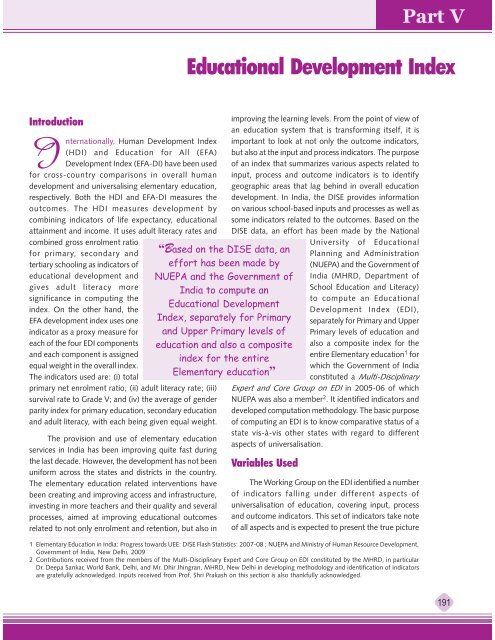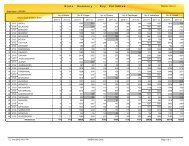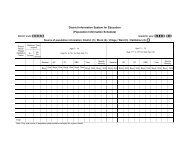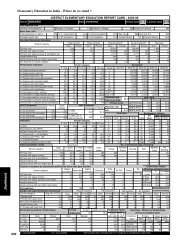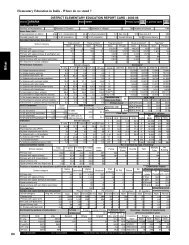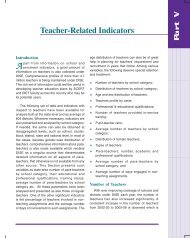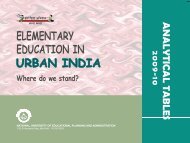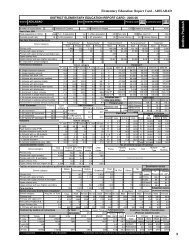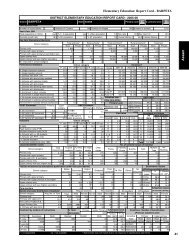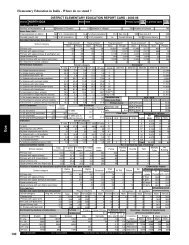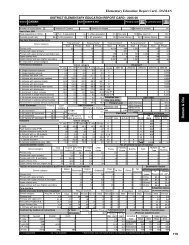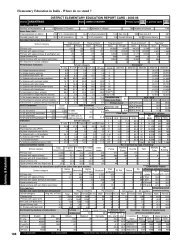Teacher Related Indicators & EDI - DISE
Teacher Related Indicators & EDI - DISE
Teacher Related Indicators & EDI - DISE
You also want an ePaper? Increase the reach of your titles
YUMPU automatically turns print PDFs into web optimized ePapers that Google loves.
Part V<br />
Educational Development Index<br />
Introduction<br />
Internationally, Human Development Index<br />
(HDI) and Education for All (EFA)<br />
Development Index (EFA-DI) have been used<br />
for cross-country comparisons in overall human<br />
development and universalising elementary education,<br />
respectively. Both the HDI and EFA-DI measures the<br />
outcomes. The HDI measures development by<br />
combining indicators of life expectancy, educational<br />
attainment and income. It uses adult literacy rates and<br />
combined gross enrolment ratio<br />
for primary, secondary and<br />
tertiary schooling as indicators of<br />
educational development and<br />
gives adult literacy more<br />
significance in computing the<br />
index. On the other hand, the<br />
EFA development index uses one<br />
indicator as a proxy measure for<br />
each of the four <strong>EDI</strong> components<br />
and each component is assigned<br />
equal weight in the overall index.<br />
The indicators used are: (i) total<br />
primary net enrolment ratio; (ii) adult literacy rate; (iii)<br />
survival rate to Grade V; and (iv) the average of gender<br />
parity index for primary education, secondary education<br />
and adult literacy, with each being given equal weight.<br />
The provision and use of elementary education<br />
services in India has been improving quite fast during<br />
the last decade. However, the development has not been<br />
uniform across the states and districts in the country.<br />
The elementary education related interventions have<br />
been creating and improving access and infrastructure,<br />
investing in more teachers and their quality and several<br />
processes, aimed at improving educational outcomes<br />
related to not only enrolment and retention, but also in<br />
“Based on the <strong>DISE</strong> data, an<br />
effort has been made by<br />
NUEPA and the Government of<br />
India to compute an<br />
Educational Development<br />
Index, separately for Primary<br />
and Upper Primary levels of<br />
education and also a composite<br />
index for the entire<br />
Elementary education”<br />
improving the learning levels. From the point of view of<br />
an education system that is transforming itself, it is<br />
important to look at not only the outcome indicators,<br />
but also at the input and process indicators. The purpose<br />
of an index that summarizes various aspects related to<br />
input, process and outcome indicators is to identify<br />
geographic areas that lag behind in overall education<br />
development. In India, the <strong>DISE</strong> provides information<br />
on various school-based inputs and processes as well as<br />
some indicators related to the outcomes. Based on the<br />
<strong>DISE</strong> data, an effort has been made by the National<br />
University of Educational<br />
Planning and Administration<br />
(NUEPA) and the Government of<br />
India (MHRD, Department of<br />
School Education and Literacy)<br />
to compute an Educational<br />
Development Index (<strong>EDI</strong>),<br />
separately for Primary and Upper<br />
Primary levels of education and<br />
also a composite index for the<br />
entire Elementary education 1 for<br />
which the Government of India<br />
constituted a Multi-Disciplinary<br />
Expert and Core Group on <strong>EDI</strong> in 2005-06 of which<br />
NUEPA was also a member 2 . It identified indicators and<br />
developed computation methodology. The basic purpose<br />
of computing an <strong>EDI</strong> is to know comparative status of a<br />
state vis-à-vis other states with regard to different<br />
aspects of universalisation.<br />
Variables Used<br />
The Working Group on the <strong>EDI</strong> identified a number<br />
of indicators falling under different aspects of<br />
universalisation of education, covering input, process<br />
and outcome indicators. This set of indicators take note<br />
of all aspects and is expected to present the true picture<br />
1 Elementary Education in India: Progress towards UEE: <strong>DISE</strong> Flash Statistics: 2007-08 ; NUEPA and Ministry of Human Resource Development,<br />
Government of India, New Delhi, 2009<br />
2 Contributions received from the members of the Multi-Disciplinary Expert and Core Group on <strong>EDI</strong> constituted by the MHRD, in particular<br />
Dr. Deepa Sankar, World Bank, Delhi, and Mr. Dhir Jhingran, MHRD, New Delhi in developing methodology and identification of indicators<br />
are gratefully acknowledged. Inputs received from Prof. Shri Prakash on this section is also thankfully acknowledged.<br />
191


